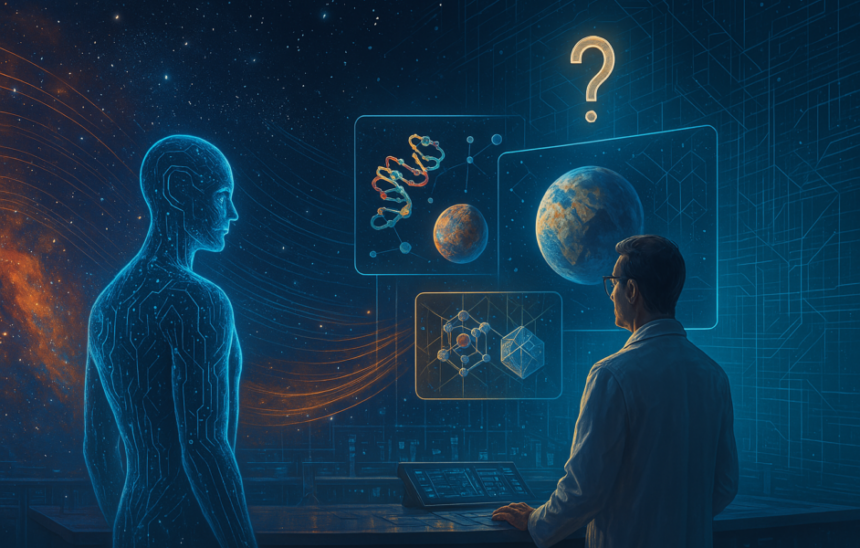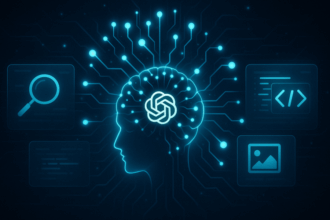Artificial intelligence (AI) is rapidly moving forward with applications spreading across industries such as healthcare, finance, education and entertainment. The most exciting area of AI is scientific research. The ability to process vast amounts of data, recognize and predict complex patterns is to accelerate the pace at which scientific discoveries are made. This raises an interesting question: can AI think outside the box and generate truly novel ideas like human scientists? To explore this, we must look at how AI is currently being used in scientific discoveries and whether it can produce truly original ideas.
The growing role of AI in scientific discovery
AI has made great strides in a wide range of science fields, including drug discovery, genomics, materials science, climate research, and astronomy. By processing large datasets that humans cannot process, AI has helped identify potential drug candidates, model climate change, and propose new theories about the universe.
For example, MIT researchers used AI to discover new antibiotics within days targeting bacteria resistant to existing drugs. In biology, Deepmind’s Alphafold solved the protein folding problem and predicted 3D protein structures, which are essential for drug development. In material science, AI models like GNOME have predicted millions of new crystals that can redefine technologies such as batteries and solar cells. AI also proposed new ways to model physical phenomena, supporting astronomy by discovering exoplanets and gravitational lenses. In climate science, AI has helped to enhance climate forecasting and model extreme weather events.
Can ai be thought outside the box?
Although AI’s contribution to scientific discovery cannot be denied, questions remain. Can you really think outside the box? Human scientific advances often rely on intuition, creativity and courage to challenge existing paradigms. These breakthroughs usually come from scientists who are willing to think beyond traditional wisdom.
However, AI is driven by data. They analyze patterns and predict outcomes based on the information provided, but there are no imaginative, abstract ideas that humans do. In this sense, AI creativity is different from human creativity. AI operates within the constraints of its data and algorithms, which limits its ability to perform truly creative and ready-to-use thoughts.
However, the situation is more complicated. It demonstrates that AI can generate new hypotheses, propose innovative solutions, and challenge established knowledge in some areas. For example, machine learning models are used to create new compounds and design materials that humans have not previously considered. In some cases, these findings led to breakthroughs that human researchers would have been difficult to achieve on their own.
Discussions to support AI creativity
Advocates argue that AI demonstrates creativity by generating ideas that are not immediately apparent to human researchers. For example, Alphafold used a new deep learning architecture to solve the protein folding challenge that had escaped scientists for decades. Similarly, Google’s Gemini 2.0-powered AI has been used to create original hypotheses and research suggestions, allowing scientists to bridge the gaps between different scientific domains. Research from the University of Chicago suggests that AI can generate “alien” hypotheses: innovative ideas that humans don’t think about. These examples suggest that AI could think outside the box by proposing novel ideas.
Discussion of AI creativity
Critics argue that AI is essentially limited because it relies on existing knowledge and data sets. The work is like filling the data gaps rather than questioning existing assumptions. Critics say AI creativity is constrained by trained data, preventing it from making truly groundbreaking discoveries.
Thomas Wolf, a well-known AI expert, argues that true innovation, like Einstein’s idea, requires asking whole new questions and challenging traditional wisdom. Large-scale language models (LLM) and other AI systems have not demonstrated their ability to generate truly new insights despite extensive training. Therefore, AI is viewed as an efficient tool for learning rather than a genuine thinker capable of breaking through established scientific paradigms.
Furthermore, AI lacks the human qualities of intuition, emotion, and accident that often drive creative breakthroughs. AI relies on logical and systematic processes to operate within predefined algorithms. According to entrepreneurs, this algorithmic approach differs greatly from the unpredictable and spontaneous nature of human creativity. Sciencedirect’s research paper also argues that AI-generated creativity may seem innovative, but does not provide the same depth of insight as human creativity.
Synthesis and meaning
AI can certainly think outside the box in a way, especially when it comes to identifying patterns and proposing new solutions, but it differs from human creativity in that it relies on data-driven analysis rather than intuition or life experience. The role of AI in scientific discovery is better understood as a partner for human scientists rather than as an alternative.
Research from Imperial College Business School shows that AI can complement traditional scientific methods, uncover new principles, and help tackle lower research productivity. Similarly, researchers at Kellogg have discovered that AI can have a positive impact in the science field, but emphasize that training and interdisciplinary collaboration are essential to fully exploiting the possibilities of AI.
The most important advances in science can come from combining human creativity with the analytical capabilities of AI. Together, they can accelerate breakthroughs and lead to discoveries that are more than we can imagine now.
Conclusion
AI is transforming scientific research by accelerating discovery and introducing new ideas. AI demonstrates its ability to generate hypotheses and identify new patterns, but it cannot think outside the box just like humans do. As of 2025, continuous development suggests that its impact on science will continue to grow. However, it is important that AI pays attention to transparency, verification and ethical integration, and supports human efforts rather than replacing them. By collaborating with human creativity, AI can enhance scientific advancement and open new paths for exploration.









